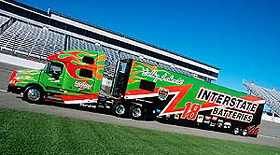Swift Vs. Prime: The Battle For Supremacy.
Topic 10593 | Page 4

I didn't receive a Private message.
What's with the private message system here? Seems they don't go thru for quite a few people. Does it require high level security clearance to have your pm's flow freely?

Swift is a bigger company, has more dedicated accounts and more options for different freight in general. Prime pays more and seems to have more flatbed if thats your thing.
If you are considering Swift you might want to check out Schneider as well.
What are the differences between Swift and Schneider? Can you line it up kind of like Brett did for Swift and Prime? I don't care about home time at all. I would like to be out on the road for as long as possible. Space can be a thing, but I can also do without, so if a company puts you in an LW like Prime is said to be doing it really doesn't mean too much to me.
They are similar companies; similar opportunities (OTR, Regional , Dedicated, Reefer , Flat, Intermodal), competing in the same markets. As far as I know Swift does not have a tank division though, Schneider does.
I can only speak from my experience with Swift. I have been driving for them for over 2 years on a dedicated grocery account (Walmart). They are a huge company, very good company sponsored school (if you choose that route), very good driver facing management (DMs, Safety, and Planners), and many opportunities once you gain some experience. I can honestly say they have always treated me fairly and professionally. Most important they keep me moving.
A very good choice to get your start with, and like me (and many others) you may continue with them beyond your first year of experience. The first year is key, once past that you will have many, many choices if you prefer a change from your initial employer.
What is dedicated and what is intermodal?
Regional:
Regional Route
Usually refers to a driver hauling freight within one particular region of the country. You might be in the "Southeast Regional Division" or "Midwest Regional". Regional route drivers often get home on the weekends which is one of the main appeals for this type of route.
OTR:
Over The Road
OTR driving normally means you'll be hauling freight to various customers throughout your company's hauling region. It often entails being gone from home for two to three weeks at a time.
Intermodal:
Transporting freight using two or more transportation modes. An example would be freight that is moved by truck from the shipper's dock to the rail yard, then placed on a train to the next rail yard, and finally returned to a truck for delivery to the receiving customer.
In trucking when you hear someone refer to an intermodal job they're normally talking about hauling shipping containers to and from the shipyards and railyards.
Dm:
Dispatcher, Fleet Manager, Driver Manager
The primary person a driver communicates with at his/her company. A dispatcher can play many roles, depending on the company's structure. Dispatchers may assign freight, file requests for home time, relay messages between the driver and management, inform customer service of any delays, change appointment times, and report information to the load planners.Reefer:
A refrigerated trailer.
OOS:
When a violation by either a driver or company is confirmed, an out-of-service order removes either the driver or the vehicle from the roadway until the violation is corrected.
TheLittleTrucker asks:
What are the differences between Swift and Schneider? Can you line it up kind of like Brett did for Swift and Prime?
Swift uses white trucks and Schneider's are orange. Here's the Trucking Truth listings. read them: Schneider National and Swift Transportation
All this, and more, is available in the links across the top of every Trucking Truth page.

TheLittleTrucker asks:
What are the differences between Swift and Schneider? Can you line it up kind of like Brett did for Swift and Prime?
Swift uses white trucks and Schneider's are orange. Here's the Trucking Truth listings. read them: Schneider National and Swift Transportation
All this, and more, is available in the links across the top of every Trucking Truth page.
One thing to note is that Schneider does not have it own CDL school like swift. They will pay for your education if you use one of there approved driving schools. They also have a $6,000 tuition reimbursement for new drivers. The bonus to that is that you can train locally in the comfort of your own town.
CDL:
Commercial Driver's License (CDL)
A CDL is required to drive any of the following vehicles:
- Any combination of vehicles with a gross combined weight rating (GCWR) of 26,001 or more pounds, providing the gross vehicle weight rating (GVWR) of the vehicle being towed is in excess of 10,000 pounds.
- Any single vehicle with a GVWR of 26,001 or more pounds, or any such vehicle towing another not in excess of 10,000 pounds.
- Any vehicle, regardless of size, designed to transport 16 or more persons, including the driver.
- Any vehicle required by federal regulations to be placarded while transporting hazardous materials.

TheLittleTrucker asks:
What are the differences between Swift and Schneider? Can you line it up kind of like Brett did for Swift and Prime?
Swift uses white trucks and Schneider's are orange. Here's the Trucking Truth listings. read them: Schneider National and Swift Transportation
All this, and more, is available in the links across the top of every Trucking Truth page.
Errol, so you're saying the only differences between Swift and Schneider are the color of the trucks? Lol. And btw, I already checked out those tabs on the website but I thought I would ask current drivers because some of that information seems to be out-of-date. For instance the Swift part about having to be 23 is no longer true. You just have to be at least "21.5 years old," as the recruiter put it. So I figure current drivers might have a better clue because I don't know how much of that information is updated. And you know the websites don't really help.
HOS:
Hours Of Service
HOS refers to the logbook hours of service regulations.
TheLittleTrucker asks:
What are the differences between Swift and Schneider? Can you line it up kind of like Brett did for Swift and Prime?
Swift uses white trucks and Schneider's are orange. Here's the Trucking Truth listings. read them: Schneider National and Swift Transportation
All this, and more, is available in the links across the top of every Trucking Truth page.
One thing to note is that Schneider does not have it own CDL school like swift. They will pay for your education if you use one of there approved driving schools. They also have a $6,000 tuition reimbursement for new drivers. The bonus to that is that you can train locally in the comfort of your own town.
OK that is a good difference to take note of. Thanks for the helpful feedback.
CDL:
Commercial Driver's License (CDL)
A CDL is required to drive any of the following vehicles:
- Any combination of vehicles with a gross combined weight rating (GCWR) of 26,001 or more pounds, providing the gross vehicle weight rating (GVWR) of the vehicle being towed is in excess of 10,000 pounds.
- Any single vehicle with a GVWR of 26,001 or more pounds, or any such vehicle towing another not in excess of 10,000 pounds.
- Any vehicle, regardless of size, designed to transport 16 or more persons, including the driver.
- Any vehicle required by federal regulations to be placarded while transporting hazardous materials.
Yes, my reply was a bit silly. The underlying idea, though is generally companies are similar. Swift has kept me busy, averaging around 2500 miles per week. I get the home time I like (that comes to 2 weeks out/3 days home and up from there).
I have gotten all huffy about some inconsistencies, but a phone call to my DM got it all explained and straightened out. Even the Memphis Fleet manager has time for drivers, as the occasion warrants. This is from personal experience.
I can't compare Swift with Schneider, but you can find similar Schneider thoughts on TT. When my year obligation is up in February, I'll take a more serious look around, but I don't really feel a "I'm outta here!" need to move on.
Dm:
Dispatcher, Fleet Manager, Driver Manager
The primary person a driver communicates with at his/her company. A dispatcher can play many roles, depending on the company's structure. Dispatchers may assign freight, file requests for home time, relay messages between the driver and management, inform customer service of any delays, change appointment times, and report information to the load planners.Fleet Manager:
Dispatcher, Fleet Manager, Driver Manager
The primary person a driver communicates with at his/her company. A dispatcher can play many roles, depending on the company's structure. Dispatchers may assign freight, file requests for home time, relay messages between the driver and management, inform customer service of any delays, change appointment times, and report information to the load planners.
I was also trying to decide between Swift, Prime, and Knight.
I liked the much higher starting pay with Prime, but I am not thrilled about the LW trucks and the lack of regional/dedicated routes as an option for later on. As for the LW truck, it is not the lack of interior space that bothers me. What bothers me is the fact that it is a LIGHT WEIGHT truck. As I understand it, the truck weighs about 5k less, so they can in turn haul 5k more of cargo. Having 5K more pushing a tractor weighing 5k less down a hill, or the 5k less truck trying to pull 5k more up the hill, does not sound like the safest thing. It seems that combination would be better left to experienced drivers. Now I know that Prime has a lot of new drivers doing just that, but I am not too sure of it. That and the very low governing on their trucks is "primarily" while I didn't put Prime at the top of my list. (they are #3).
I looked very hard at Swift. I like their home options and good chance at regional/dedicated routes after a while. I also like their free tuition for me since I was a vet. But what ended up putting Swift to #2 on my list is that they use team driving when you are getting your OTR training. The first week is solo but after that it is team driving. If I am supposed to be getting trained, mentored, and evaluated, I do not see how that is possible if my trainer is sleeping or otherwise unengaged when I am driving. I have read posts on here about how a trainee missed a turn when his trainer was sleeping. I want my trainer up front with me so he or she can be giving me advice, pointers, and warnings as we go.
That is why I eventually picked Knight as #1. Their OTR training is solo, no team driving. I don't get a vet scholarship, but that's okay. I'll pay the $2900. I also like that they have no contract. Like Swift, Knight also uses a sliding CPM scale based on the length of the run. I asked their recruiter why that was. She said that since the company sort of promises to give you a certain number of miles and if you are getting shorter runs, you aren't getting the promised miles so they pay more for shorter runs to kind of make up for it. Okay, I guess. I still think I'd like a straight rate though.
My plan now is to run OTR, lower 48 for a year to get some experience and miles under my belt and then switch to their Western 11 region.
Dedicated Route:
A driver or carrier who transports cargo between regular, prescribed routes. Normally it means a driver will be dedicated to working for one particular customer like Walmart or Home Depot and they will only haul freight for that customer. You'll often hear drivers say something like, "I'm on the Walmart dedicated account."
Regional:
Regional Route
Usually refers to a driver hauling freight within one particular region of the country. You might be in the "Southeast Regional Division" or "Midwest Regional". Regional route drivers often get home on the weekends which is one of the main appeals for this type of route.
OTR:
Over The Road
OTR driving normally means you'll be hauling freight to various customers throughout your company's hauling region. It often entails being gone from home for two to three weeks at a time.
CPM:
Cents Per Mile
Drivers are often paid by the mile and it's given in cents per mile, or cpm.
Dave is concerned:
But what ended up putting Swift to #2 on my list is that they use team driving when you are getting your OTR training. The first week is solo but after that it is team driving. If I am supposed to be getting trained, mentored, and evaluated, I do not see how that is possible if my trainer is sleeping or otherwise unengaged when I am driving.
The mentor time (the first (I forget) 400 hours of driving), you and your mentor are together. The first 40 hours driving, your mentor is sitting in the passenger seat all the time you drive. After that is when yo switch to team. No, your mentor should not be in the bunk with the curtain closed 100% of his off time - the only seat to sit in is the passenger seat, so he'll be up there. I can only speak for my mentor here, but he actually set an alarm so that he was up, and watching, all the time I was at a shipper/receiver. A good mentor is always "engaged" with your driving.
After you get the hang of driving, you probably wish your mentor stays in bed, so you can do the \whole delivery or pick-up on your own. I used the GPS for routing exclusively, and only missed a turn a couple of times (because the GPS screen can be misleading sometimes). Then you push the green REROUTE button, and get back to the road. Remember some companies, I believe, send you out with another student team driving for a while.
Also, it seems Swift's 400 driving hours comes down to maybe one of the shorter training times before you're First Seat solo.
Shipper:
The customer who is shipping the freight. This is where the driver will pick up a load and then deliver it to the receiver or consignee.
OTR:
Over The Road
OTR driving normally means you'll be hauling freight to various customers throughout your company's hauling region. It often entails being gone from home for two to three weeks at a time.
New Reply:
New! Check out our help videos for a better understanding of our forum features

















Preview:
This topic has the following tags:
Knight Transport Prime Inc Schneider National Swift Transport Choosing A Trucking Company Company Sponsored CDL Training Truck Driver Salary Truck Equipment Questions







 TT On Facebook
TT On Facebook
They are similar companies; similar opportunities (OTR, Regional , Dedicated, Reefer , Flat, Intermodal), competing in the same markets. As far as I know Swift does not have a tank division though, Schneider does.
I can only speak from my experience with Swift. I have been driving for them for over 2 years on a dedicated grocery account (Walmart). They are a huge company, very good company sponsored school (if you choose that route), very good driver facing management (DMs, Safety, and Planners), and many opportunities once you gain some experience. I can honestly say they have always treated me fairly and professionally. Most important they keep me moving.
A very good choice to get your start with, and like me (and many others) you may continue with them beyond your first year of experience. The first year is key, once past that you will have many, many choices if you prefer a change from your initial employer.
Regional:
Regional Route
Usually refers to a driver hauling freight within one particular region of the country. You might be in the "Southeast Regional Division" or "Midwest Regional". Regional route drivers often get home on the weekends which is one of the main appeals for this type of route.
OTR:
Over The Road
OTR driving normally means you'll be hauling freight to various customers throughout your company's hauling region. It often entails being gone from home for two to three weeks at a time.
Intermodal:
Transporting freight using two or more transportation modes. An example would be freight that is moved by truck from the shipper's dock to the rail yard, then placed on a train to the next rail yard, and finally returned to a truck for delivery to the receiving customer.
In trucking when you hear someone refer to an intermodal job they're normally talking about hauling shipping containers to and from the shipyards and railyards.
Dm:
Dispatcher, Fleet Manager, Driver Manager
The primary person a driver communicates with at his/her company. A dispatcher can play many roles, depending on the company's structure. Dispatchers may assign freight, file requests for home time, relay messages between the driver and management, inform customer service of any delays, change appointment times, and report information to the load planners.Reefer:
A refrigerated trailer.
OOS:
When a violation by either a driver or company is confirmed, an out-of-service order removes either the driver or the vehicle from the roadway until the violation is corrected.